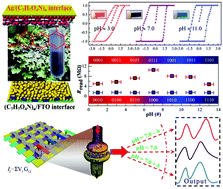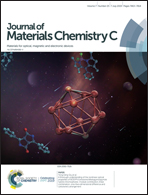An excellent pH-controlled resistive switching memory device based on self-colored (C7H7O4N)n extracted from a lichen plant†
Abstract
Despite much progress in the semiconductor-integrated circuit technology for resistive switching memory, it is still hard to implement on the extremely complex neuromorphic networks. Resistive switching memory with multilevel operations and multi-state behaviors shows its inherent potential in neural networks. Herein, a resistive switching memory device with the structure of Ag/(C7H7O4N)n/F-doped SnO2 (FTO) showed a unique capacitance effect and negative differential resistance (NDR) states; also, a non-zero-crossing hysteresis loop and multistate resistances in terms of programming and erasing processes were feasible. Uniquely, a pH-controlled behavior was observed for the first time during the self-colored switching layer of (C7H7O4N)n extracted from a lichen plant. The chemical potential gradients generating an emf in the interfaces were responsible for this effect, and the ion transportation in the switching layer and the related redox reaction under the bias voltage played dominant roles in the multi-state memory behaviors and remarkable NDR states. This device provides a promising application in the neuromorphic artificial synapse as well as a selection of memory states.



 Please wait while we load your content...
Please wait while we load your content...